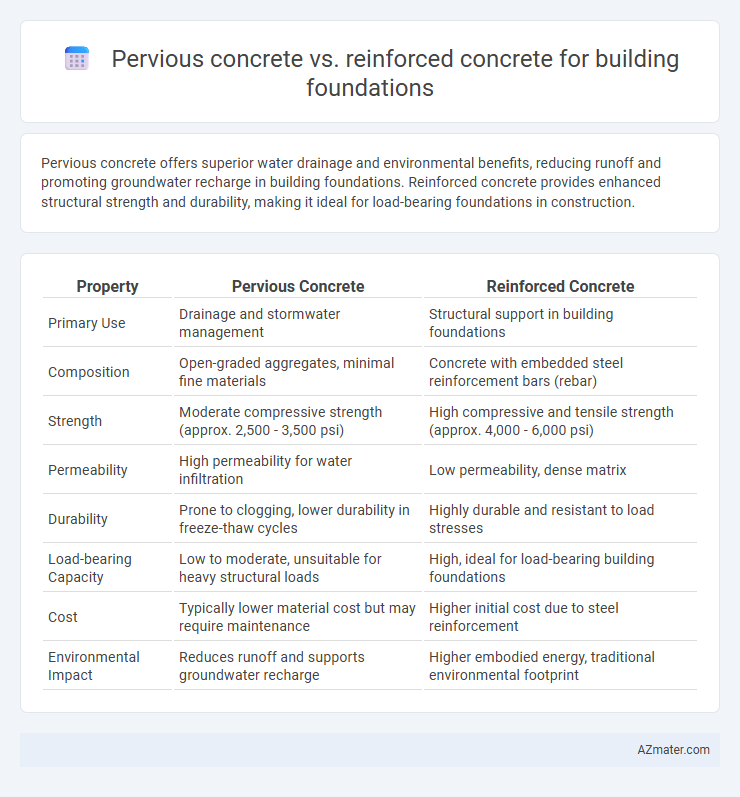Pervious concrete offers superior water drainage and environmental benefits, reducing runoff and promoting groundwater recharge in building foundations. Reinforced concrete provides enhanced structural strength and durability, making it ideal for load-bearing foundations in construction.
Table of Comparison
| Property | Pervious Concrete | Reinforced Concrete |
|---|---|---|
| Primary Use | Drainage and stormwater management | Structural support in building foundations |
| Composition | Open-graded aggregates, minimal fine materials | Concrete with embedded steel reinforcement bars (rebar) |
| Strength | Moderate compressive strength (approx. 2,500 - 3,500 psi) | High compressive and tensile strength (approx. 4,000 - 6,000 psi) |
| Permeability | High permeability for water infiltration | Low permeability, dense matrix |
| Durability | Prone to clogging, lower durability in freeze-thaw cycles | Highly durable and resistant to load stresses |
| Load-bearing Capacity | Low to moderate, unsuitable for heavy structural loads | High, ideal for load-bearing building foundations |
| Cost | Typically lower material cost but may require maintenance | Higher initial cost due to steel reinforcement |
| Environmental Impact | Reduces runoff and supports groundwater recharge | Higher embodied energy, traditional environmental footprint |
Introduction to Pervious and Reinforced Concrete
Pervious concrete is a porous material designed to allow water to pass through, reducing runoff and promoting groundwater recharge, making it ideal for sustainable foundation solutions. Reinforced concrete combines concrete with steel reinforcement bars to enhance strength and durability, ensuring robust support for building foundations under heavy loads. Both materials serve distinct roles in foundation design, with pervious concrete enhancing environmental performance and reinforced concrete providing structural integrity.
Key Properties of Pervious Concrete
Pervious concrete features high porosity, allowing water to permeate through its structure, which reduces stormwater runoff and promotes groundwater recharge. Its lower compressive strength compared to reinforced concrete limits its use primarily to non-structural or light load-bearing foundation applications. The material's permeability and ability to mitigate water accumulation make it ideal for sustainable building foundations in areas with drainage concerns.
Core Characteristics of Reinforced Concrete
Reinforced concrete combines concrete's compressive strength with steel reinforcement's tensile strength, providing exceptional load-bearing capacity and durability for building foundations. It exhibits high resistance to bending, shear, and tensile forces, making it ideal for supporting heavy structural loads and withstanding environmental stresses. This composite material's core characteristics include improved toughness, enhanced structural integrity, and long-lasting performance in various foundation applications.
Durability Comparison: Pervious vs Reinforced Concrete
Pervious concrete offers enhanced drainage capabilities, reducing water accumulation and potentially lowering freeze-thaw damage risks in building foundations. Reinforced concrete, with embedded steel bars, provides superior tensile strength and resistance to structural loads, contributing to long-term durability under heavy stress. While pervious concrete excels in water permeability, reinforced concrete remains the preferred choice for foundational durability due to its robustness against cracking and environmental wear.
Structural Performance in Building Foundations
Pervious concrete offers enhanced water permeability, reducing hydrostatic pressure and improving drainage beneath building foundations, which helps prevent soil erosion and foundation settlement. Reinforced concrete provides superior tensile strength and load-bearing capacity, ensuring stability and resistance to cracking under heavy structural loads. Combining pervious concrete's drainage benefits with reinforced concrete's structural durability can optimize foundation performance in buildings situated on variable soil conditions.
Water Drainage and Permeability Differences
Pervious concrete offers superior water drainage and permeability for building foundations due to its high porosity, allowing water to pass through and reduce surface runoff effectively. Reinforced concrete, while structurally stronger with embedded steel bars, is typically impermeable, causing water to pool and potentially increase hydrostatic pressure around foundations. Choosing pervious concrete enhances groundwater recharge and minimizes drainage issues, whereas reinforced concrete requires additional drainage solutions to manage water accumulation.
Environmental Impact of Both Concrete Types
Pervious concrete significantly reduces stormwater runoff and enhances groundwater recharge, mitigating urban flooding and lowering the heat island effect, which benefits the surrounding ecosystem. Reinforced concrete, while offering high structural strength, often involves higher cement content and steel usage, leading to greater carbon dioxide emissions and environmental degradation during production. Choosing pervious concrete for building foundations promotes sustainable water management and reduces the overall carbon footprint compared to conventional reinforced concrete.
Maintenance and Longevity Considerations
Pervious concrete offers superior drainage and reduces maintenance related to water pooling and erosion in building foundations, enhancing durability in wet climates. Reinforced concrete provides higher structural strength and longevity, requiring routine inspections to prevent corrosion of steel reinforcement that can compromise foundation integrity. Proper maintenance of reinforced concrete, such as sealing cracks and controlling moisture, extends lifespan, while pervious concrete demands periodic debris removal to maintain permeability and overall performance.
Cost Analysis for Foundation Projects
Pervious concrete typically offers cost savings in foundation projects due to reduced stormwater management expenses and lower excavation requirements compared to reinforced concrete. Reinforced concrete has higher material and labor costs attributed to steel reinforcement and complex formwork, but it provides superior structural strength and durability for load-bearing foundations. Evaluating lifecycle expenses, pervious concrete reduces site development costs, while reinforced concrete demands greater initial investment but may yield long-term stability and minimal maintenance for critical foundation applications.
Choosing the Right Concrete for Building Foundations
Pervious concrete offers enhanced water drainage and reduced runoff, making it ideal for foundations in areas prone to heavy rainfall or requiring groundwater recharge. Reinforced concrete provides superior strength and load-bearing capacity, essential for supporting heavy structural loads and ensuring long-term durability in residential and commercial buildings. Selecting the right concrete depends on site-specific factors such as soil permeability, load requirements, and environmental conditions to optimize foundation performance and sustainability.

Infographic: Pervious concrete vs Reinforced concrete for Building foundation
 azmater.com
azmater.com